Employee Development Report: Training Needs, Analysis and Program
VerifiedAdded on 2019/10/31
|11
|2096
|184
Report
AI Summary
This report provides a comprehensive analysis of employee development, emphasizing the critical role of training needs assessment and program design in enhancing organizational performance. It begins by evaluating case questions related to training needs, prioritizing these needs based on their impact on employee responsibilities, and outlining the steps involved in creating an effective training program. The report stresses the importance of clear communication throughout the training process and addresses organizational compensation reviews to boost employee morale and productivity. It also includes questions to consider when interviewing potential employees, focusing on performance evaluation, goal alignment, and the integration of training within the organizational budget. Furthermore, the report identifies and explains various types of employee training needs, including technical, skills, and soft skills training, highlighting their significance in fostering a well-rounded and competent workforce. The report concludes by underscoring the importance of employee development as a core organizational strategy and the necessity of continuous assessment and training to achieve organizational goals. This report is contributed by a student and available on Desklib, a platform providing AI-based study tools.
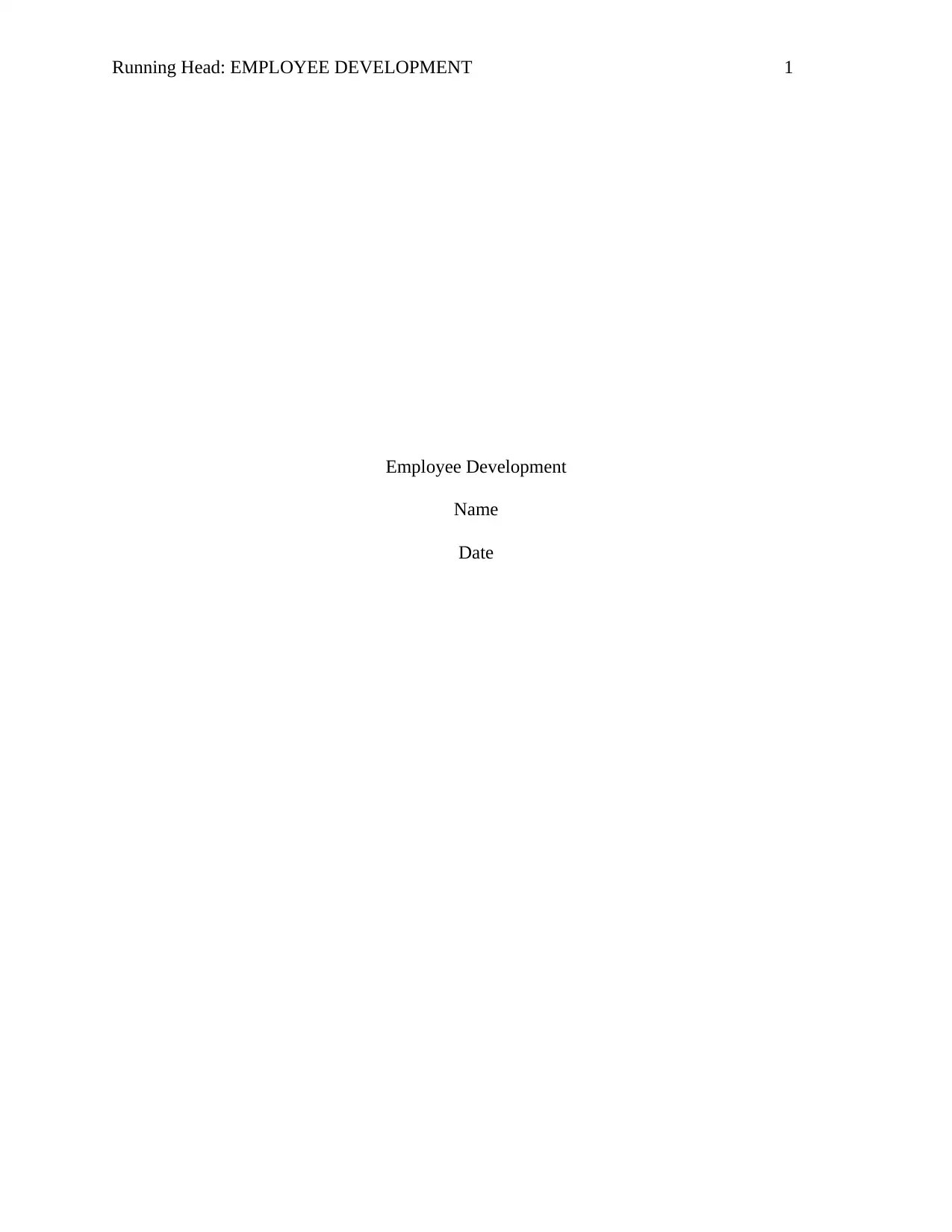
Running Head: EMPLOYEE DEVELOPMENT 1
Employee Development
Name
Date
Employee Development
Name
Date
Paraphrase This Document
Need a fresh take? Get an instant paraphrase of this document with our AI Paraphraser
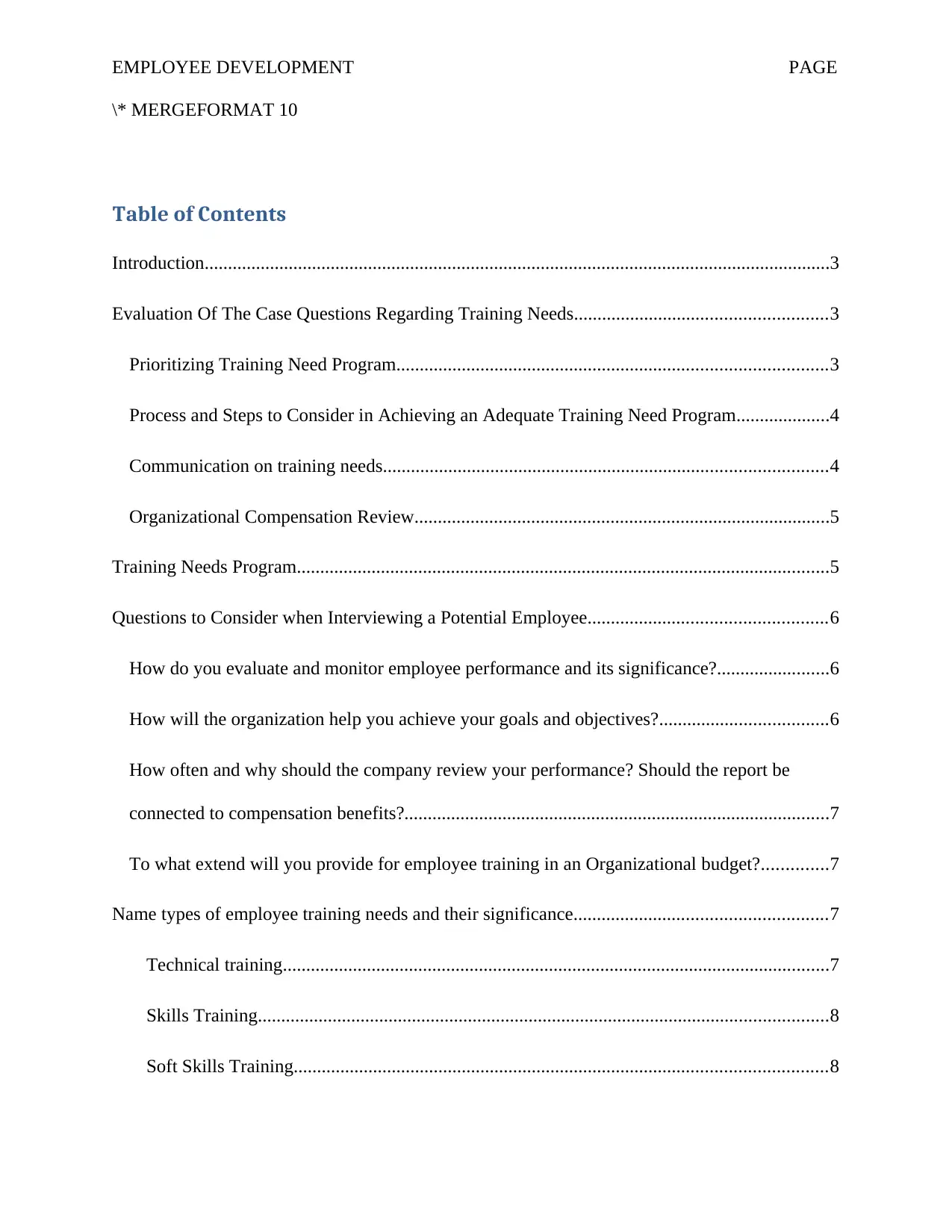
EMPLOYEE DEVELOPMENT PAGE
\* MERGEFORMAT 10
Table of Contents
Introduction......................................................................................................................................3
Evaluation Of The Case Questions Regarding Training Needs......................................................3
Prioritizing Training Need Program............................................................................................3
Process and Steps to Consider in Achieving an Adequate Training Need Program....................4
Communication on training needs...............................................................................................4
Organizational Compensation Review.........................................................................................5
Training Needs Program..................................................................................................................5
Questions to Consider when Interviewing a Potential Employee...................................................6
How do you evaluate and monitor employee performance and its significance?........................6
How will the organization help you achieve your goals and objectives?....................................6
How often and why should the company review your performance? Should the report be
connected to compensation benefits?...........................................................................................7
To what extend will you provide for employee training in an Organizational budget?..............7
Name types of employee training needs and their significance......................................................7
Technical training.....................................................................................................................7
Skills Training..........................................................................................................................8
Soft Skills Training..................................................................................................................8
\* MERGEFORMAT 10
Table of Contents
Introduction......................................................................................................................................3
Evaluation Of The Case Questions Regarding Training Needs......................................................3
Prioritizing Training Need Program............................................................................................3
Process and Steps to Consider in Achieving an Adequate Training Need Program....................4
Communication on training needs...............................................................................................4
Organizational Compensation Review.........................................................................................5
Training Needs Program..................................................................................................................5
Questions to Consider when Interviewing a Potential Employee...................................................6
How do you evaluate and monitor employee performance and its significance?........................6
How will the organization help you achieve your goals and objectives?....................................6
How often and why should the company review your performance? Should the report be
connected to compensation benefits?...........................................................................................7
To what extend will you provide for employee training in an Organizational budget?..............7
Name types of employee training needs and their significance......................................................7
Technical training.....................................................................................................................7
Skills Training..........................................................................................................................8
Soft Skills Training..................................................................................................................8
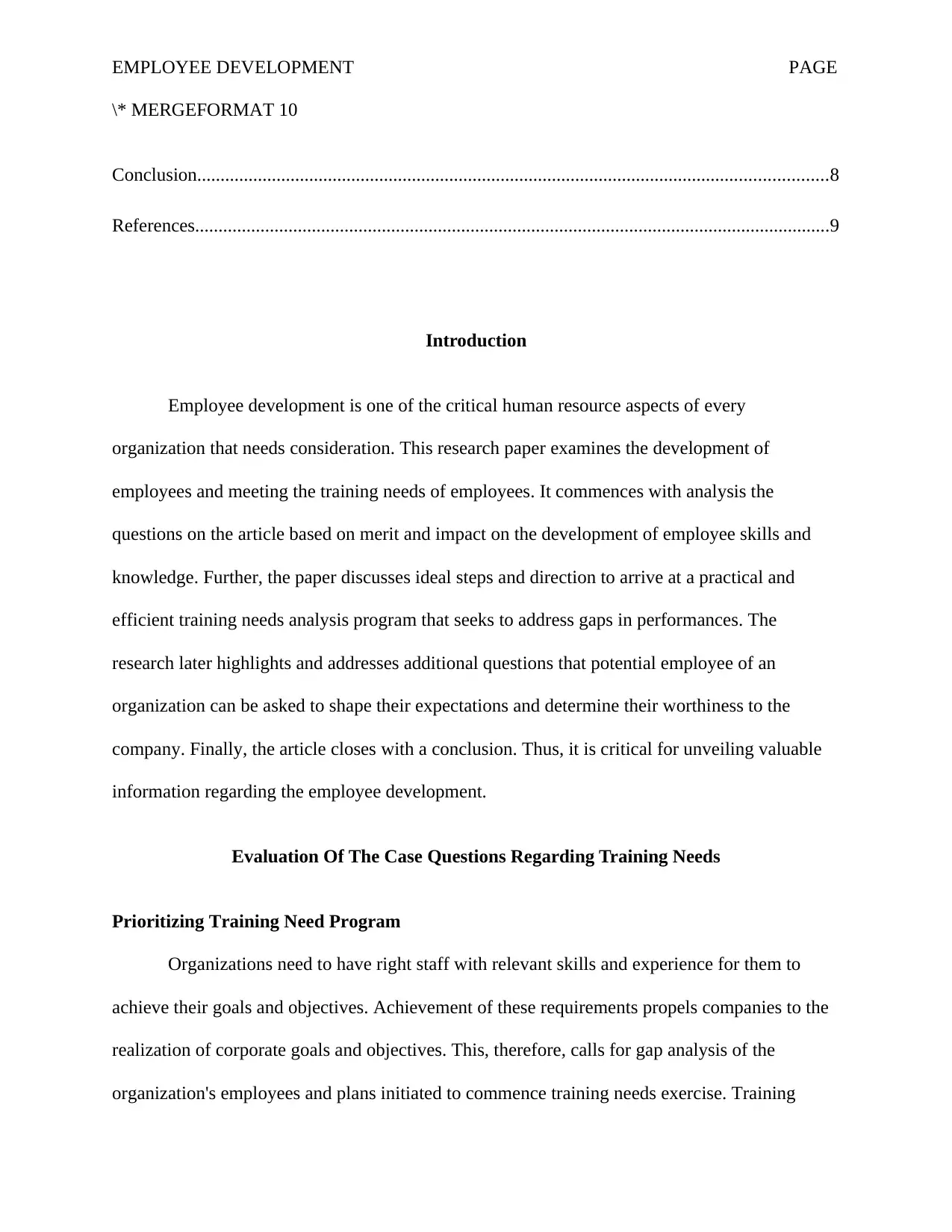
EMPLOYEE DEVELOPMENT PAGE
\* MERGEFORMAT 10
Conclusion.......................................................................................................................................8
References........................................................................................................................................9
Introduction
Employee development is one of the critical human resource aspects of every
organization that needs consideration. This research paper examines the development of
employees and meeting the training needs of employees. It commences with analysis the
questions on the article based on merit and impact on the development of employee skills and
knowledge. Further, the paper discusses ideal steps and direction to arrive at a practical and
efficient training needs analysis program that seeks to address gaps in performances. The
research later highlights and addresses additional questions that potential employee of an
organization can be asked to shape their expectations and determine their worthiness to the
company. Finally, the article closes with a conclusion. Thus, it is critical for unveiling valuable
information regarding the employee development.
Evaluation Of The Case Questions Regarding Training Needs
Prioritizing Training Need Program
Organizations need to have right staff with relevant skills and experience for them to
achieve their goals and objectives. Achievement of these requirements propels companies to the
realization of corporate goals and objectives. This, therefore, calls for gap analysis of the
organization's employees and plans initiated to commence training needs exercise. Training
\* MERGEFORMAT 10
Conclusion.......................................................................................................................................8
References........................................................................................................................................9
Introduction
Employee development is one of the critical human resource aspects of every
organization that needs consideration. This research paper examines the development of
employees and meeting the training needs of employees. It commences with analysis the
questions on the article based on merit and impact on the development of employee skills and
knowledge. Further, the paper discusses ideal steps and direction to arrive at a practical and
efficient training needs analysis program that seeks to address gaps in performances. The
research later highlights and addresses additional questions that potential employee of an
organization can be asked to shape their expectations and determine their worthiness to the
company. Finally, the article closes with a conclusion. Thus, it is critical for unveiling valuable
information regarding the employee development.
Evaluation Of The Case Questions Regarding Training Needs
Prioritizing Training Need Program
Organizations need to have right staff with relevant skills and experience for them to
achieve their goals and objectives. Achievement of these requirements propels companies to the
realization of corporate goals and objectives. This, therefore, calls for gap analysis of the
organization's employees and plans initiated to commence training needs exercise. Training
⊘ This is a preview!⊘
Do you want full access?
Subscribe today to unlock all pages.

Trusted by 1+ million students worldwide
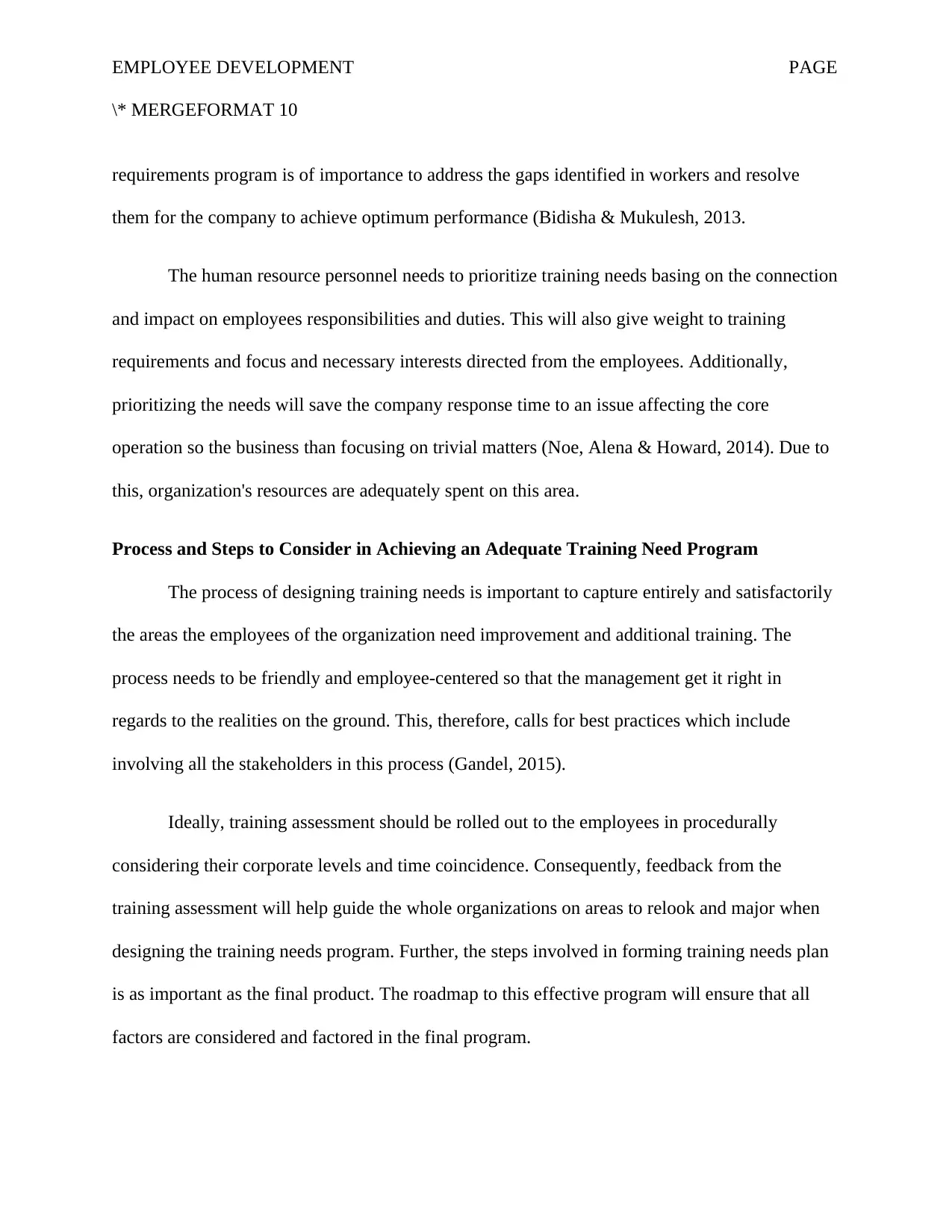
EMPLOYEE DEVELOPMENT PAGE
\* MERGEFORMAT 10
requirements program is of importance to address the gaps identified in workers and resolve
them for the company to achieve optimum performance (Bidisha & Mukulesh, 2013.
The human resource personnel needs to prioritize training needs basing on the connection
and impact on employees responsibilities and duties. This will also give weight to training
requirements and focus and necessary interests directed from the employees. Additionally,
prioritizing the needs will save the company response time to an issue affecting the core
operation so the business than focusing on trivial matters (Noe, Alena & Howard, 2014). Due to
this, organization's resources are adequately spent on this area.
Process and Steps to Consider in Achieving an Adequate Training Need Program
The process of designing training needs is important to capture entirely and satisfactorily
the areas the employees of the organization need improvement and additional training. The
process needs to be friendly and employee-centered so that the management get it right in
regards to the realities on the ground. This, therefore, calls for best practices which include
involving all the stakeholders in this process (Gandel, 2015).
Ideally, training assessment should be rolled out to the employees in procedurally
considering their corporate levels and time coincidence. Consequently, feedback from the
training assessment will help guide the whole organizations on areas to relook and major when
designing the training needs program. Further, the steps involved in forming training needs plan
is as important as the final product. The roadmap to this effective program will ensure that all
factors are considered and factored in the final program.
\* MERGEFORMAT 10
requirements program is of importance to address the gaps identified in workers and resolve
them for the company to achieve optimum performance (Bidisha & Mukulesh, 2013.
The human resource personnel needs to prioritize training needs basing on the connection
and impact on employees responsibilities and duties. This will also give weight to training
requirements and focus and necessary interests directed from the employees. Additionally,
prioritizing the needs will save the company response time to an issue affecting the core
operation so the business than focusing on trivial matters (Noe, Alena & Howard, 2014). Due to
this, organization's resources are adequately spent on this area.
Process and Steps to Consider in Achieving an Adequate Training Need Program
The process of designing training needs is important to capture entirely and satisfactorily
the areas the employees of the organization need improvement and additional training. The
process needs to be friendly and employee-centered so that the management get it right in
regards to the realities on the ground. This, therefore, calls for best practices which include
involving all the stakeholders in this process (Gandel, 2015).
Ideally, training assessment should be rolled out to the employees in procedurally
considering their corporate levels and time coincidence. Consequently, feedback from the
training assessment will help guide the whole organizations on areas to relook and major when
designing the training needs program. Further, the steps involved in forming training needs plan
is as important as the final product. The roadmap to this effective program will ensure that all
factors are considered and factored in the final program.
Paraphrase This Document
Need a fresh take? Get an instant paraphrase of this document with our AI Paraphraser
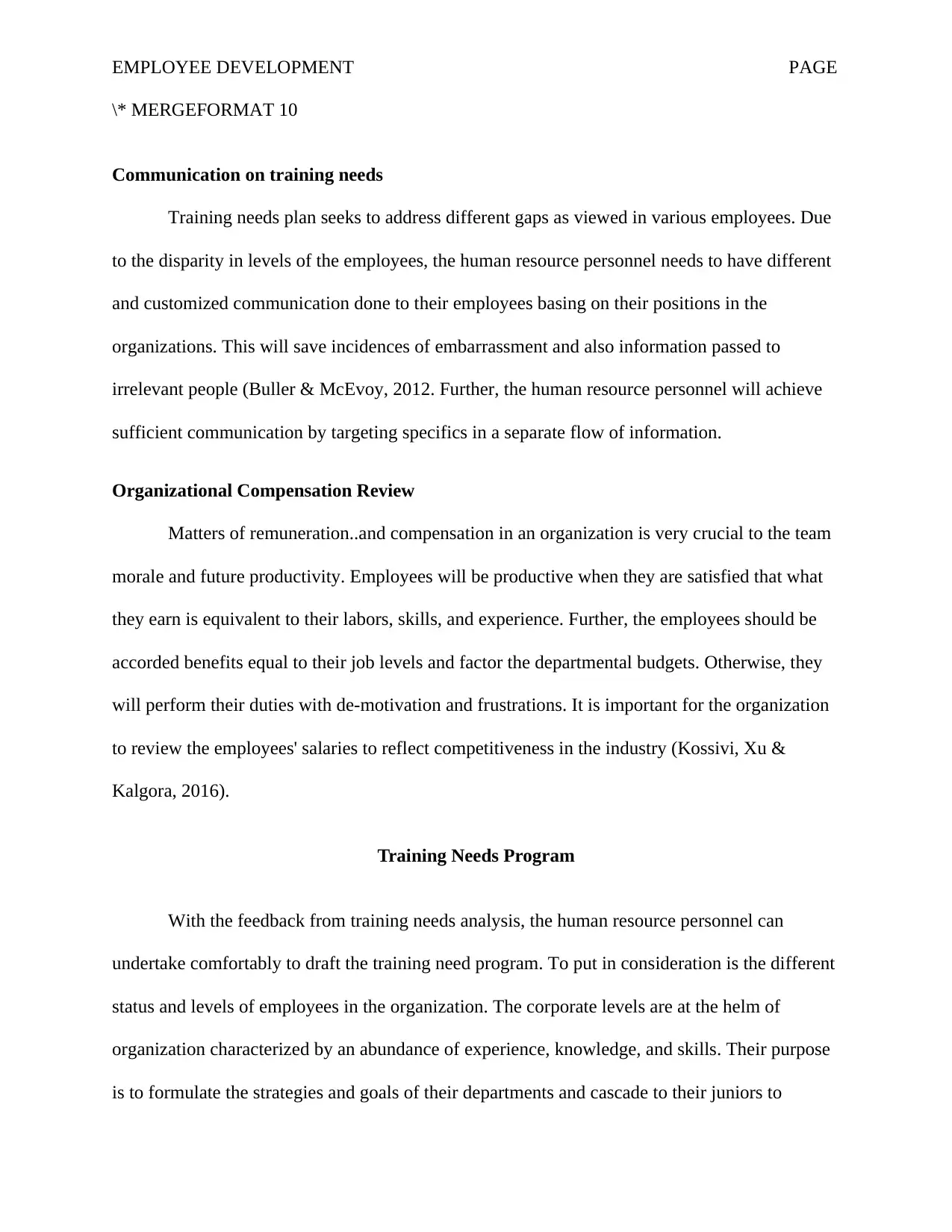
EMPLOYEE DEVELOPMENT PAGE
\* MERGEFORMAT 10
Communication on training needs
Training needs plan seeks to address different gaps as viewed in various employees. Due
to the disparity in levels of the employees, the human resource personnel needs to have different
and customized communication done to their employees basing on their positions in the
organizations. This will save incidences of embarrassment and also information passed to
irrelevant people (Buller & McEvoy, 2012. Further, the human resource personnel will achieve
sufficient communication by targeting specifics in a separate flow of information.
Organizational Compensation Review
Matters of remuneration..and compensation in an organization is very crucial to the team
morale and future productivity. Employees will be productive when they are satisfied that what
they earn is equivalent to their labors, skills, and experience. Further, the employees should be
accorded benefits equal to their job levels and factor the departmental budgets. Otherwise, they
will perform their duties with de-motivation and frustrations. It is important for the organization
to review the employees' salaries to reflect competitiveness in the industry (Kossivi, Xu &
Kalgora, 2016).
Training Needs Program
With the feedback from training needs analysis, the human resource personnel can
undertake comfortably to draft the training need program. To put in consideration is the different
status and levels of employees in the organization. The corporate levels are at the helm of
organization characterized by an abundance of experience, knowledge, and skills. Their purpose
is to formulate the strategies and goals of their departments and cascade to their juniors to
\* MERGEFORMAT 10
Communication on training needs
Training needs plan seeks to address different gaps as viewed in various employees. Due
to the disparity in levels of the employees, the human resource personnel needs to have different
and customized communication done to their employees basing on their positions in the
organizations. This will save incidences of embarrassment and also information passed to
irrelevant people (Buller & McEvoy, 2012. Further, the human resource personnel will achieve
sufficient communication by targeting specifics in a separate flow of information.
Organizational Compensation Review
Matters of remuneration..and compensation in an organization is very crucial to the team
morale and future productivity. Employees will be productive when they are satisfied that what
they earn is equivalent to their labors, skills, and experience. Further, the employees should be
accorded benefits equal to their job levels and factor the departmental budgets. Otherwise, they
will perform their duties with de-motivation and frustrations. It is important for the organization
to review the employees' salaries to reflect competitiveness in the industry (Kossivi, Xu &
Kalgora, 2016).
Training Needs Program
With the feedback from training needs analysis, the human resource personnel can
undertake comfortably to draft the training need program. To put in consideration is the different
status and levels of employees in the organization. The corporate levels are at the helm of
organization characterized by an abundance of experience, knowledge, and skills. Their purpose
is to formulate the strategies and goals of their departments and cascade to their juniors to
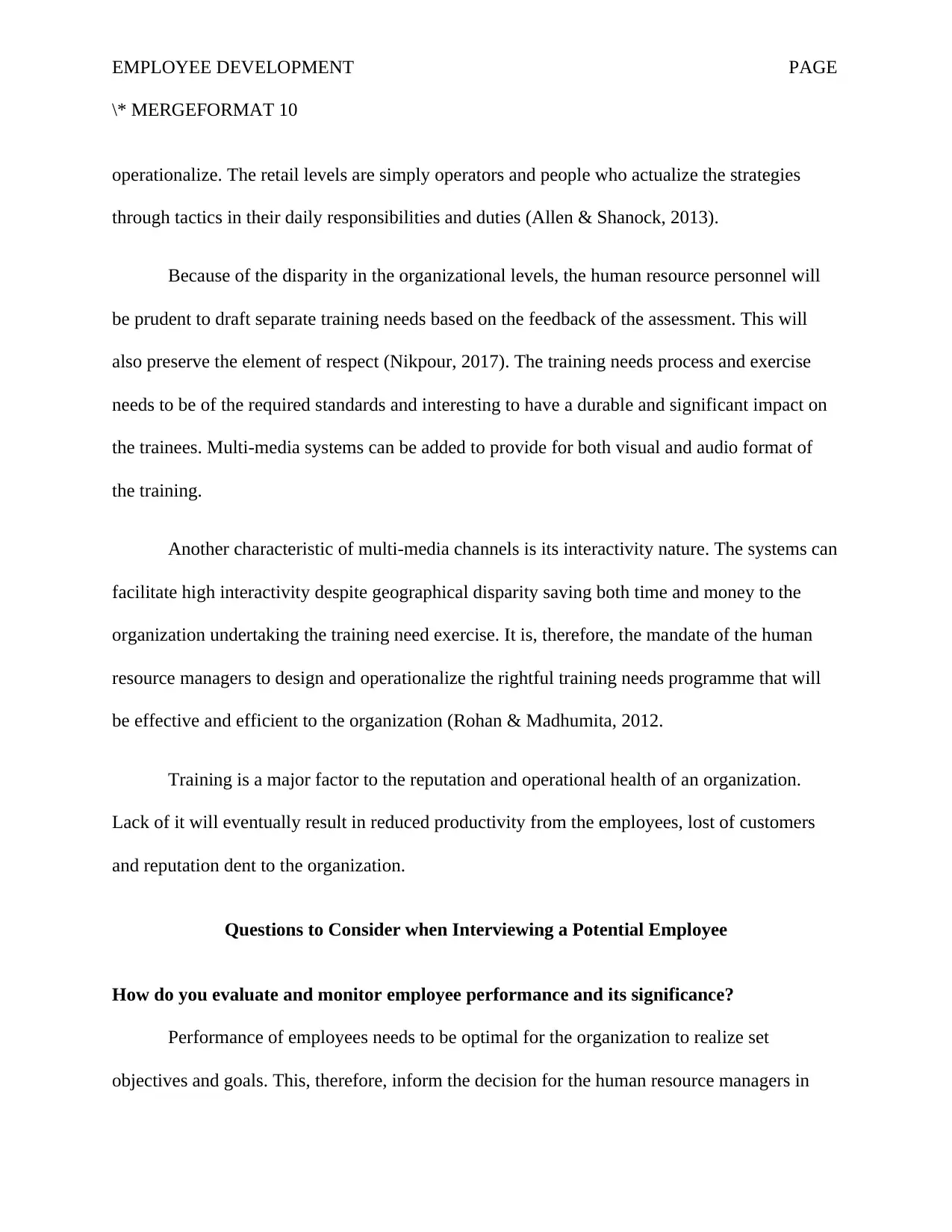
EMPLOYEE DEVELOPMENT PAGE
\* MERGEFORMAT 10
operationalize. The retail levels are simply operators and people who actualize the strategies
through tactics in their daily responsibilities and duties (Allen & Shanock, 2013).
Because of the disparity in the organizational levels, the human resource personnel will
be prudent to draft separate training needs based on the feedback of the assessment. This will
also preserve the element of respect (Nikpour, 2017). The training needs process and exercise
needs to be of the required standards and interesting to have a durable and significant impact on
the trainees. Multi-media systems can be added to provide for both visual and audio format of
the training.
Another characteristic of multi-media channels is its interactivity nature. The systems can
facilitate high interactivity despite geographical disparity saving both time and money to the
organization undertaking the training need exercise. It is, therefore, the mandate of the human
resource managers to design and operationalize the rightful training needs programme that will
be effective and efficient to the organization (Rohan & Madhumita, 2012.
Training is a major factor to the reputation and operational health of an organization.
Lack of it will eventually result in reduced productivity from the employees, lost of customers
and reputation dent to the organization.
Questions to Consider when Interviewing a Potential Employee
How do you evaluate and monitor employee performance and its significance?
Performance of employees needs to be optimal for the organization to realize set
objectives and goals. This, therefore, inform the decision for the human resource managers in
\* MERGEFORMAT 10
operationalize. The retail levels are simply operators and people who actualize the strategies
through tactics in their daily responsibilities and duties (Allen & Shanock, 2013).
Because of the disparity in the organizational levels, the human resource personnel will
be prudent to draft separate training needs based on the feedback of the assessment. This will
also preserve the element of respect (Nikpour, 2017). The training needs process and exercise
needs to be of the required standards and interesting to have a durable and significant impact on
the trainees. Multi-media systems can be added to provide for both visual and audio format of
the training.
Another characteristic of multi-media channels is its interactivity nature. The systems can
facilitate high interactivity despite geographical disparity saving both time and money to the
organization undertaking the training need exercise. It is, therefore, the mandate of the human
resource managers to design and operationalize the rightful training needs programme that will
be effective and efficient to the organization (Rohan & Madhumita, 2012.
Training is a major factor to the reputation and operational health of an organization.
Lack of it will eventually result in reduced productivity from the employees, lost of customers
and reputation dent to the organization.
Questions to Consider when Interviewing a Potential Employee
How do you evaluate and monitor employee performance and its significance?
Performance of employees needs to be optimal for the organization to realize set
objectives and goals. This, therefore, inform the decision for the human resource managers in
⊘ This is a preview!⊘
Do you want full access?
Subscribe today to unlock all pages.

Trusted by 1+ million students worldwide
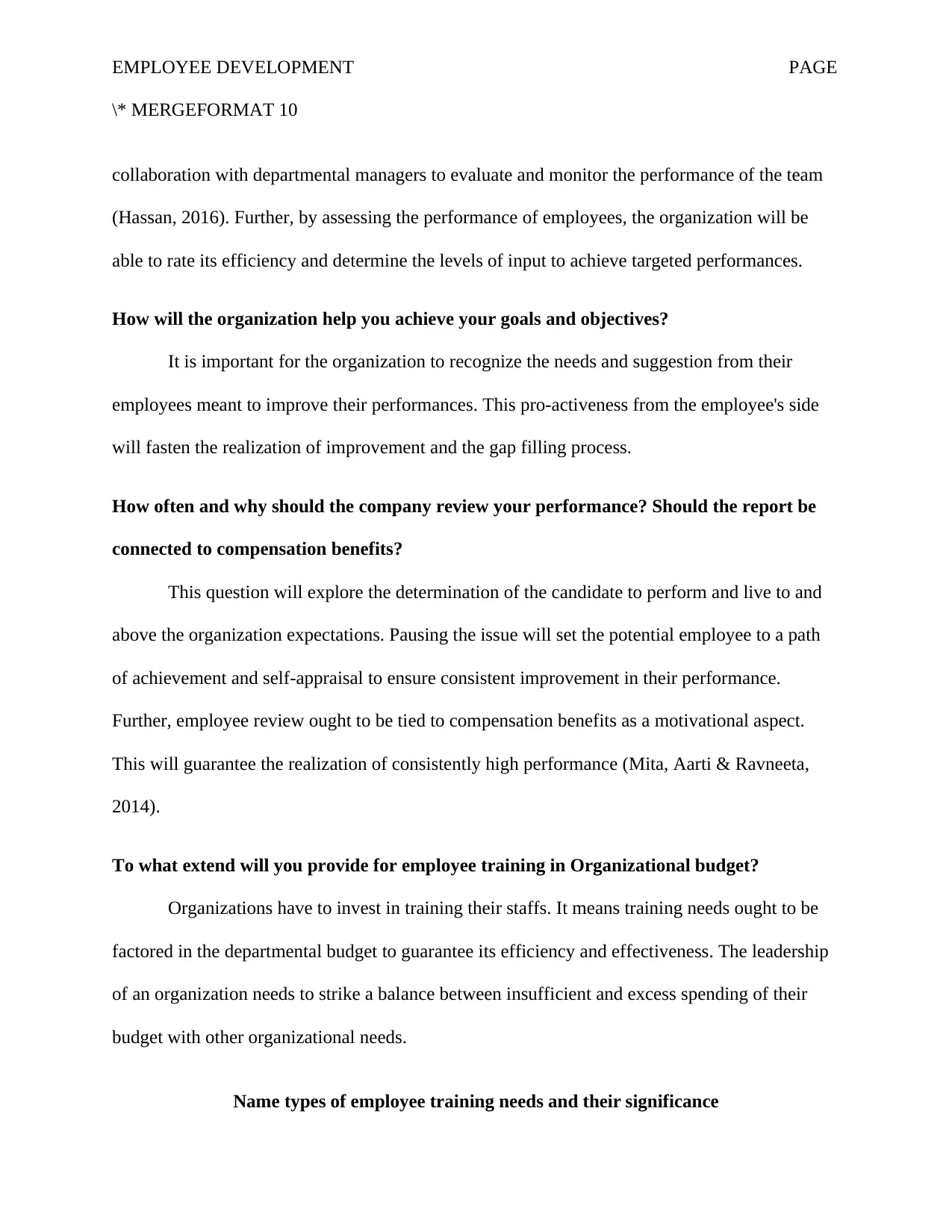
EMPLOYEE DEVELOPMENT PAGE
\* MERGEFORMAT 10
collaboration with departmental managers to evaluate and monitor the performance of the team
(Hassan, 2016). Further, by assessing the performance of employees, the organization will be
able to rate its efficiency and determine the levels of input to achieve targeted performances.
How will the organization help you achieve your goals and objectives?
It is important for the organization to recognize the needs and suggestion from their
employees meant to improve their performances. This pro-activeness from the employee's side
will fasten the realization of improvement and the gap filling process.
How often and why should the company review your performance? Should the report be
connected to compensation benefits?
This question will explore the determination of the candidate to perform and live to and
above the organization expectations. Pausing the issue will set the potential employee to a path
of achievement and self-appraisal to ensure consistent improvement in their performance.
Further, employee review ought to be tied to compensation benefits as a motivational aspect.
This will guarantee the realization of consistently high performance (Mita, Aarti & Ravneeta,
2014).
To what extend will you provide for employee training in Organizational budget?
Organizations have to invest in training their staffs. It means training needs ought to be
factored in the departmental budget to guarantee its efficiency and effectiveness. The leadership
of an organization needs to strike a balance between insufficient and excess spending of their
budget with other organizational needs.
Name types of employee training needs and their significance
\* MERGEFORMAT 10
collaboration with departmental managers to evaluate and monitor the performance of the team
(Hassan, 2016). Further, by assessing the performance of employees, the organization will be
able to rate its efficiency and determine the levels of input to achieve targeted performances.
How will the organization help you achieve your goals and objectives?
It is important for the organization to recognize the needs and suggestion from their
employees meant to improve their performances. This pro-activeness from the employee's side
will fasten the realization of improvement and the gap filling process.
How often and why should the company review your performance? Should the report be
connected to compensation benefits?
This question will explore the determination of the candidate to perform and live to and
above the organization expectations. Pausing the issue will set the potential employee to a path
of achievement and self-appraisal to ensure consistent improvement in their performance.
Further, employee review ought to be tied to compensation benefits as a motivational aspect.
This will guarantee the realization of consistently high performance (Mita, Aarti & Ravneeta,
2014).
To what extend will you provide for employee training in Organizational budget?
Organizations have to invest in training their staffs. It means training needs ought to be
factored in the departmental budget to guarantee its efficiency and effectiveness. The leadership
of an organization needs to strike a balance between insufficient and excess spending of their
budget with other organizational needs.
Name types of employee training needs and their significance
Paraphrase This Document
Need a fresh take? Get an instant paraphrase of this document with our AI Paraphraser
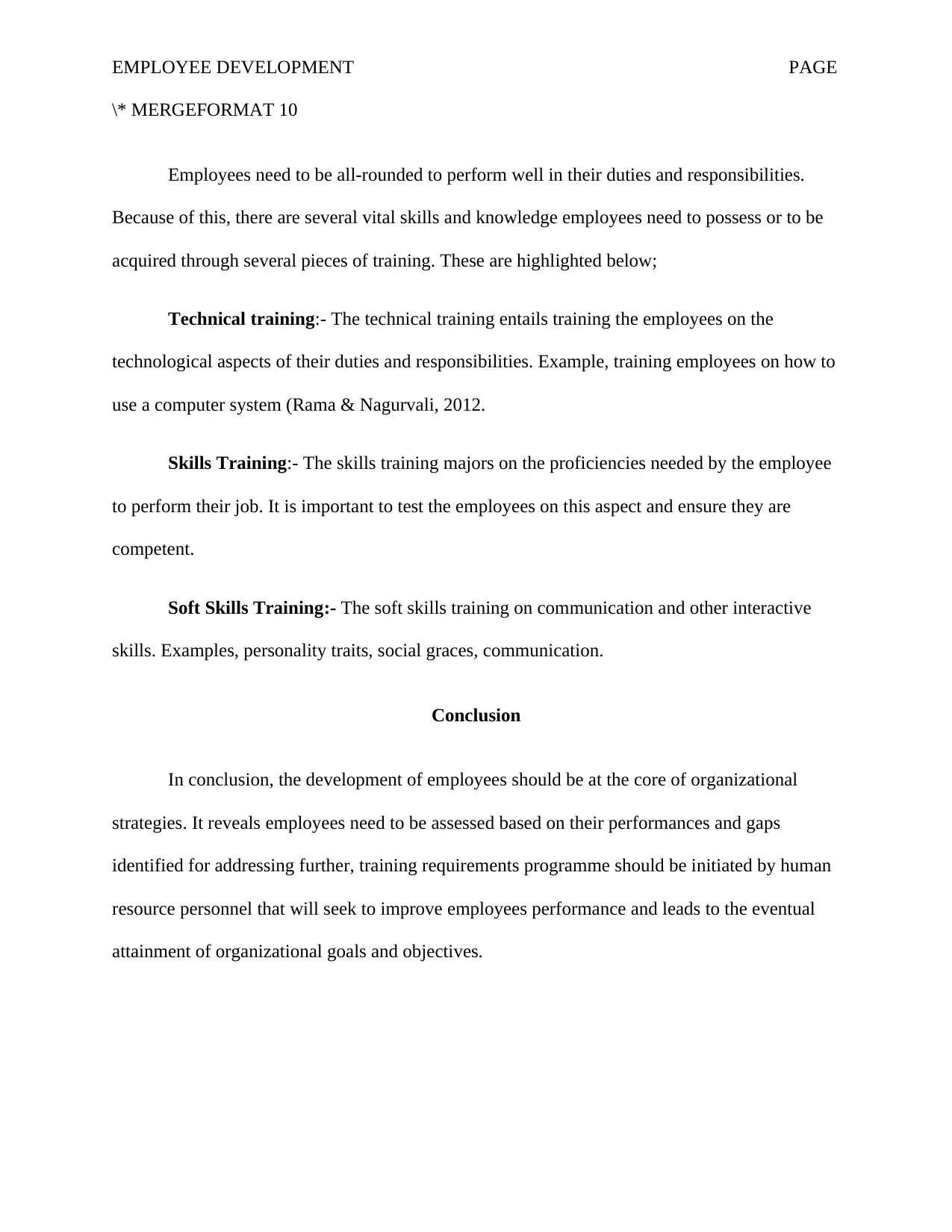
EMPLOYEE DEVELOPMENT PAGE
\* MERGEFORMAT 10
Employees need to be all-rounded to perform well in their duties and responsibilities.
Because of this, there are several vital skills and knowledge employees need to possess or to be
acquired through several pieces of training. These are highlighted below;
Technical training:- The technical training entails training the employees on the
technological aspects of their duties and responsibilities. Example, training employees on how to
use a computer system (Rama & Nagurvali, 2012.
Skills Training:- The skills training majors on the proficiencies needed by the employee
to perform their job. It is important to test the employees on this aspect and ensure they are
competent.
Soft Skills Training:- The soft skills training on communication and other interactive
skills. Examples, personality traits, social graces, communication.
Conclusion
In conclusion, the development of employees should be at the core of organizational
strategies. It reveals employees need to be assessed based on their performances and gaps
identified for addressing further, training requirements programme should be initiated by human
resource personnel that will seek to improve employees performance and leads to the eventual
attainment of organizational goals and objectives.
\* MERGEFORMAT 10
Employees need to be all-rounded to perform well in their duties and responsibilities.
Because of this, there are several vital skills and knowledge employees need to possess or to be
acquired through several pieces of training. These are highlighted below;
Technical training:- The technical training entails training the employees on the
technological aspects of their duties and responsibilities. Example, training employees on how to
use a computer system (Rama & Nagurvali, 2012.
Skills Training:- The skills training majors on the proficiencies needed by the employee
to perform their job. It is important to test the employees on this aspect and ensure they are
competent.
Soft Skills Training:- The soft skills training on communication and other interactive
skills. Examples, personality traits, social graces, communication.
Conclusion
In conclusion, the development of employees should be at the core of organizational
strategies. It reveals employees need to be assessed based on their performances and gaps
identified for addressing further, training requirements programme should be initiated by human
resource personnel that will seek to improve employees performance and leads to the eventual
attainment of organizational goals and objectives.
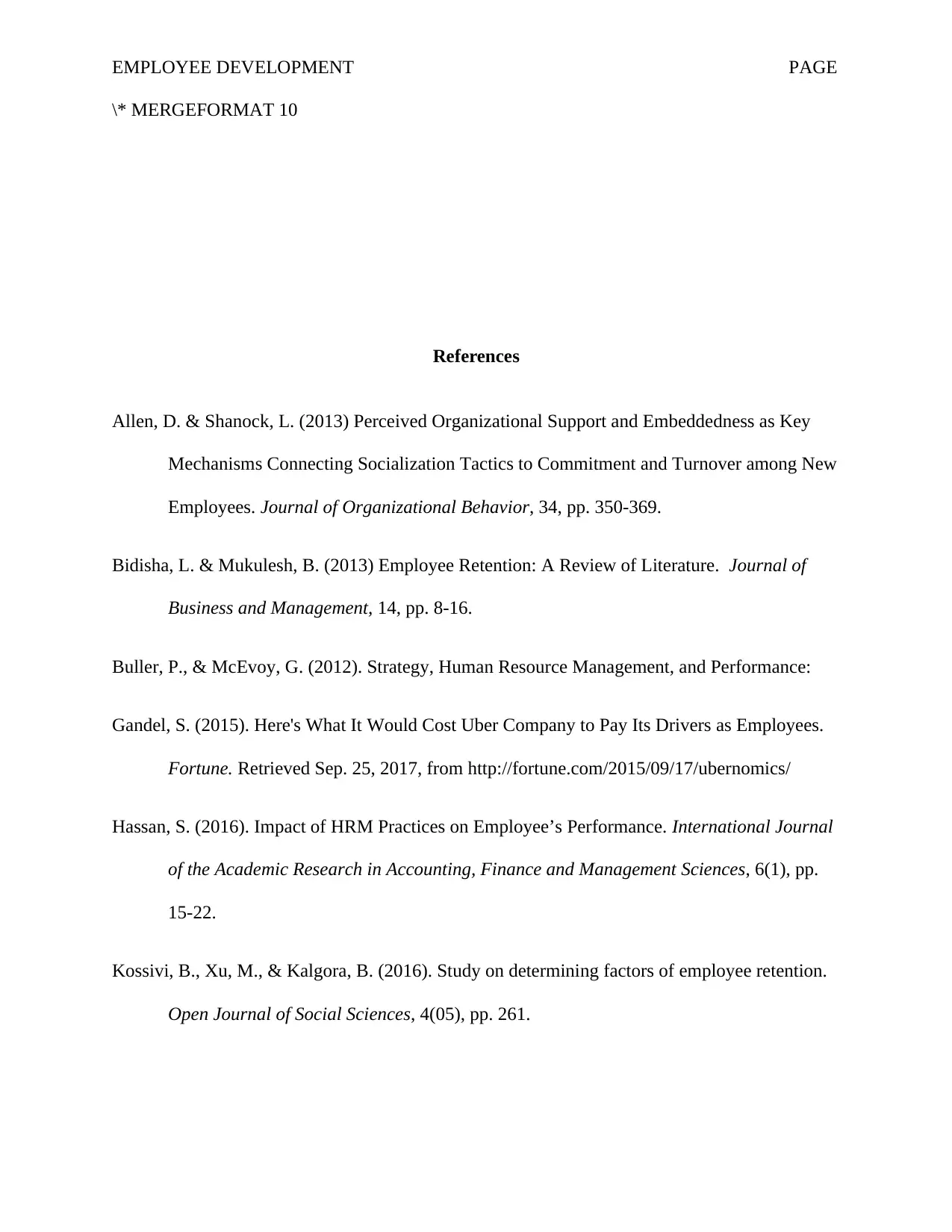
EMPLOYEE DEVELOPMENT PAGE
\* MERGEFORMAT 10
References
Allen, D. & Shanock, L. (2013) Perceived Organizational Support and Embeddedness as Key
Mechanisms Connecting Socialization Tactics to Commitment and Turnover among New
Employees. Journal of Organizational Behavior, 34, pp. 350-369.
Bidisha, L. & Mukulesh, B. (2013) Employee Retention: A Review of Literature. Journal of
Business and Management, 14, pp. 8-16.
Buller, P., & McEvoy, G. (2012). Strategy, Human Resource Management, and Performance:
Gandel, S. (2015). Here's What It Would Cost Uber Company to Pay Its Drivers as Employees.
Fortune. Retrieved Sep. 25, 2017, from http://fortune.com/2015/09/17/ubernomics/
Hassan, S. (2016). Impact of HRM Practices on Employee’s Performance. International Journal
of the Academic Research in Accounting, Finance and Management Sciences, 6(1), pp.
15-22.
Kossivi, B., Xu, M., & Kalgora, B. (2016). Study on determining factors of employee retention.
Open Journal of Social Sciences, 4(05), pp. 261.
\* MERGEFORMAT 10
References
Allen, D. & Shanock, L. (2013) Perceived Organizational Support and Embeddedness as Key
Mechanisms Connecting Socialization Tactics to Commitment and Turnover among New
Employees. Journal of Organizational Behavior, 34, pp. 350-369.
Bidisha, L. & Mukulesh, B. (2013) Employee Retention: A Review of Literature. Journal of
Business and Management, 14, pp. 8-16.
Buller, P., & McEvoy, G. (2012). Strategy, Human Resource Management, and Performance:
Gandel, S. (2015). Here's What It Would Cost Uber Company to Pay Its Drivers as Employees.
Fortune. Retrieved Sep. 25, 2017, from http://fortune.com/2015/09/17/ubernomics/
Hassan, S. (2016). Impact of HRM Practices on Employee’s Performance. International Journal
of the Academic Research in Accounting, Finance and Management Sciences, 6(1), pp.
15-22.
Kossivi, B., Xu, M., & Kalgora, B. (2016). Study on determining factors of employee retention.
Open Journal of Social Sciences, 4(05), pp. 261.
⊘ This is a preview!⊘
Do you want full access?
Subscribe today to unlock all pages.

Trusted by 1+ million students worldwide
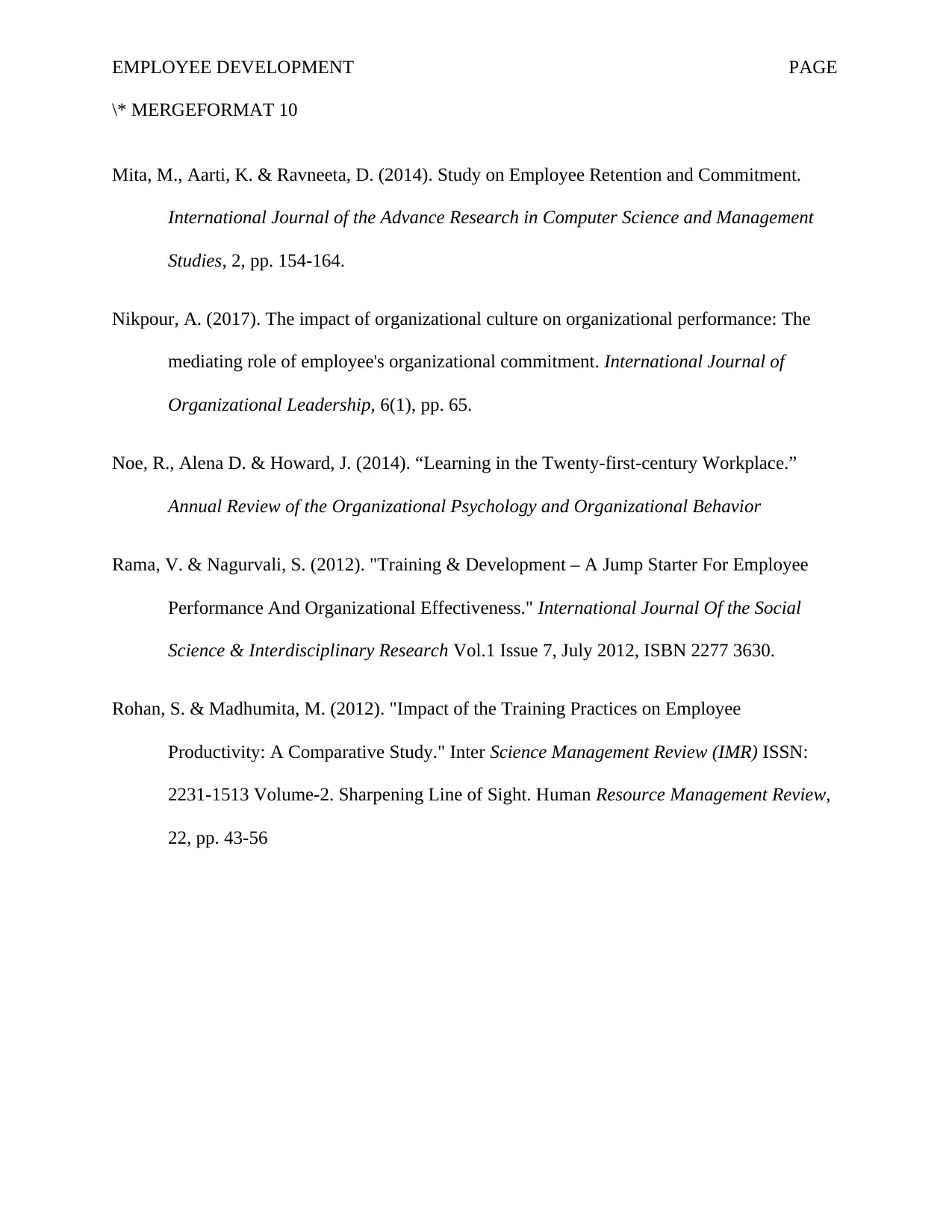
EMPLOYEE DEVELOPMENT PAGE
\* MERGEFORMAT 10
Mita, M., Aarti, K. & Ravneeta, D. (2014). Study on Employee Retention and Commitment.
International Journal of the Advance Research in Computer Science and Management
Studies, 2, pp. 154-164.
Nikpour, A. (2017). The impact of organizational culture on organizational performance: The
mediating role of employee's organizational commitment. International Journal of
Organizational Leadership, 6(1), pp. 65.
Noe, R., Alena D. & Howard, J. (2014). “Learning in the Twenty-first-century Workplace.”
Annual Review of the Organizational Psychology and Organizational Behavior
Rama, V. & Nagurvali, S. (2012). "Training & Development – A Jump Starter For Employee
Performance And Organizational Effectiveness." International Journal Of the Social
Science & Interdisciplinary Research Vol.1 Issue 7, July 2012, ISBN 2277 3630.
Rohan, S. & Madhumita, M. (2012). "Impact of the Training Practices on Employee
Productivity: A Comparative Study." Inter Science Management Review (IMR) ISSN:
2231-1513 Volume-2. Sharpening Line of Sight. Human Resource Management Review,
22, pp. 43-56
\* MERGEFORMAT 10
Mita, M., Aarti, K. & Ravneeta, D. (2014). Study on Employee Retention and Commitment.
International Journal of the Advance Research in Computer Science and Management
Studies, 2, pp. 154-164.
Nikpour, A. (2017). The impact of organizational culture on organizational performance: The
mediating role of employee's organizational commitment. International Journal of
Organizational Leadership, 6(1), pp. 65.
Noe, R., Alena D. & Howard, J. (2014). “Learning in the Twenty-first-century Workplace.”
Annual Review of the Organizational Psychology and Organizational Behavior
Rama, V. & Nagurvali, S. (2012). "Training & Development – A Jump Starter For Employee
Performance And Organizational Effectiveness." International Journal Of the Social
Science & Interdisciplinary Research Vol.1 Issue 7, July 2012, ISBN 2277 3630.
Rohan, S. & Madhumita, M. (2012). "Impact of the Training Practices on Employee
Productivity: A Comparative Study." Inter Science Management Review (IMR) ISSN:
2231-1513 Volume-2. Sharpening Line of Sight. Human Resource Management Review,
22, pp. 43-56
Paraphrase This Document
Need a fresh take? Get an instant paraphrase of this document with our AI Paraphraser

EMPLOYEE DEVELOPMENT PAGE
\* MERGEFORMAT 10
\* MERGEFORMAT 10
1 out of 11
Related Documents
Your All-in-One AI-Powered Toolkit for Academic Success.
+13062052269
info@desklib.com
Available 24*7 on WhatsApp / Email
![[object Object]](/_next/static/media/star-bottom.7253800d.svg)
Unlock your academic potential
Copyright © 2020–2025 A2Z Services. All Rights Reserved. Developed and managed by ZUCOL.





